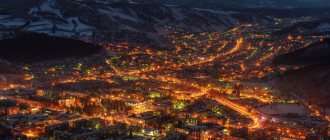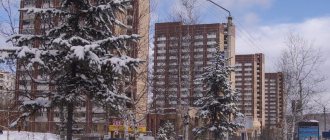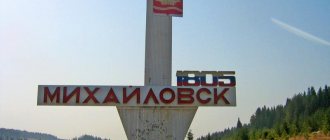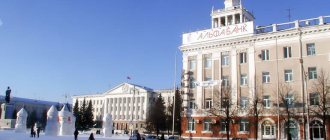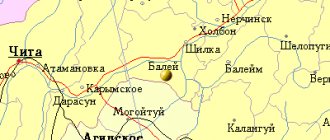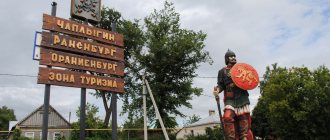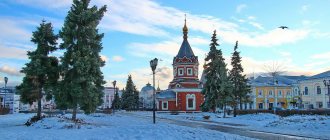Stavropol
Video: Stavropol from above
Weather in Stavropol
Stavropol is open to all winds, especially in February-March, so despite the mild climate, the weather in the city can bring surprises. Summer is dry and hot, but in June there are also showers and thunderstorms. In winter it is frosty and clear, but subtropical winds bring thaws.
Snow-covered Tukhachevsky street
View of the 6th and 7th microdistricts of Stavropol
City `s history
Like most southern cities of the country, Stavropol was founded as a fortress. The first fortifications date back to 1777. The choice of location for the construction of defensive structures was not accidental: on one side, the positions were reliably protected by a cliff to the Tashly River, and from the south there were small river beds that hampered the enemy’s advance. In the east, beyond the territory of the fortress, the approaches to it were closed by the Stavropol village, where the Cossacks lived.
At the beginning of the 19th century, the importance of Stavropol-Caucasian increased - by order of General Ermolov, the main military forces of the Ciscaucasia were concentrated in this city, and at the same time the role of the local Cossacks increased. With the change in the borders of the state and their advancement to the south, Stavropol lost its strategic importance, but continued to develop as the center of the province. After the revolution, the composition of the population of Stavropol changed significantly: many local Cossacks were evicted, and residents from Central Russia came to their homes. From 1935 to 1943 the city was officially named Voroshilovsky, while the region remained Stavropol, then the historical name was returned, however, without the second part “Caucasian”.
Library in the 20th century SKUNB named after. Lermontov
Old photos of Stavropol. Tiflis Gate, 1900
Pre-revolutionary Stavropol
Cossacks of Stavropol
The first Cossack settlers, mainly Terek and Kuban, appeared in the Stavropol region in the second half of the 18th century spontaneously, without orders from state authorities. On the territory of the modern city, the Cossack village was located within the Lower Market. The settlement was planned as a Roman camp, with a regular grid of residential buildings, the necessary administrative services and defensive ditches. The latter was a necessary precaution due to regular raids by Caucasians. Since 1825, the borders of the empire changed; the city no longer needed so many Cossacks, so they were massively resettled to the south, forcing them to abandon their homes and farms. After this, it turned out that the province had almost no military personnel of its own, so some of the local peasants - Russians and Ukrainians - were registered as Cossacks.
Stavropol Cossacks
In 1832, the Caucasian Cossack Line Army was organized with headquarters in Stavropol and the Stavropol Cossack Regiment as part of it. The new formation turned out to be effective, playing the role of both the military and the police. In case of alarm, all Cossacks and militias from the villages closest to Stavropol rose within an hour. Since that time, Stavropol and its environs have become much calmer, new farmsteads have appeared outside the fortifications, and agriculture has developed.
The history of the Stavropol Cossacks was interrupted in 1860, when the Stavropol region lost the Terek region, with its center in Vladikavkaz, and the Kuban region, with its center in Yekaterinodar. The very concept of Stavropol Cossacks was lost: only those officially assigned to the Terek and Kuban Cossacks remained in the city and surrounding areas. After the revolution, everything became even more mixed up: the Terek Cossacks were evicted to the Stavropol region, the locals to Siberia. In 1924, the Cossack cavalry units were revived, after the war a higher riding school operated in the city for the needs of the army, but in 1955 the Cossack troops were finally disbanded as morally obsolete.
Museum of Cossack History
In 1990, a congress was held in Stavropol dedicated to the revival of the local Cossacks. Today, the city has a Cossack ataman, a position officially recognized at the federal level. Not far from the station is the Museum of Cossack History with a diorama, historical clothing and weapons of the Cossacks. The Cossack Union participates in all city events and conducts educational work.
Stavropol from above
Natural attractions of Stavropol
The Sengileevskoye Reservoir
Stavropol is famous for its spectacular landscapes: hills covered with grass, shady forests, springs and waterfalls. Formally within the city, but in fact 18 km from its center, the Sengileevskoe reservoir, formed in 1958, is located – the main source of water for Stavropol. Although the local thermal power plant discharges water into it, the lake is considered clean; it is inhabited by shemaya, silver carp, bream, fisherman, and bester - a hybrid of beluga and sterlet. There are no annoying large algae in the water; Thanks to protective structures at the spillway that prevent the outflow of juveniles, the number of fish in Sengileevsky is growing every year. However, tourists will not be able to enjoy this splendor: swimming and fishing in the reservoir are prohibited.
Beach holiday
Stavropol residents are not afraid of the ban on diving into the Sengileevskoye Reservoir: there are many beaches in the city itself and in its environs. Within the boundaries of Stavropol there is Komsomolskoye Lake with a sandy shore and all amenities, but not very clean water. You can plunge into running spring water in Koryty, baths at the Cold Spring and at Mikhailovsky. The Novotroitskoye and Yegorlykskoye reservoirs are open to the public – the latter is favored by kite surfers. Within an hour's drive of the city there are many bases with well-equipped beaches on ponds and lakes, usually with good fishing. The beaches closest to Stavropol have only two drawbacks - a muddy bottom and the need to fork out for a vacation on a clean shore.
Lenin Square in Stavropol
City attractions
Founded two and a half centuries ago, Stavropol is not rich in historical and architectural monuments, but interesting tourist sites can be found there. A monument to interesting geography is 45 Parallel Street, which lies at an equal distance from both the pole and the equator.
The symbol of Stavropol is the “Cross” monument, erected in 1900 on Cathedral Hill in memory of the centenary of the death of Suvorov. The guardian angel of the city was installed already in our century on Alexander Square.
Guardian Angel of Stavropol
The German Bridge across the Mamaika River, built by prisoners of war during the First World War, stands apart. The object resembles the ruins of a Roman aqueduct in the middle of a forest. Once upon a time it was supposed to become a railway, now it is a simulator for climbers.
German bridge over the Mamaika river
Open-air museums and parks of Stavropol
A visit to the archaeological sites in the Tatar settlement and the botanical garden is great entertainment for the whole day. The first is located in a protected area, so it can only be visited with a guide; relaxation in the garden is available to everyone for a modest fee.
Botanical Garden of Stavropol
The largest botanical garden in the southern part of the country contains 17 collections of plants from around the world. Although there are noisy city highways nearby, peace and quiet reign on the alleys, lawns and in the garden's greenhouse. Educational institutions introduce new plants, conduct educational programs for schoolchildren, and create landscape design projects. From March to November, the Stavropol Botanical Garden is open daily from 9 a.m. to 6 p.m.; during the rest of the year it closes an hour earlier. A ticket for schoolchildren costs 50 rubles, for adults – 100 rubles, with a tour – 2 times more expensive.
Botanical Garden of Stavropol
Tatar settlement
In the forests near Stavropol, at its southern borders, traces of Koban, Scythian, Sarmatian and Khazar settlements were discovered: roads, fortifications, temples, burial grounds from the 8th century. BC e. according to the 10th century n. e. In order not to damage the reserve, it is prohibited to hunt, pick mushrooms and berries, or be unorganized in the forest. A three-hour excursion costs from 180 rubles per person. You need to prepare for a trip to the settlement as you would for a small hike: choose comfortable clothes, provide protection from the sun, take water and some food with you, since there is basically no tourist infrastructure nearby. The road will pass through the hills - tourists are required to be in good physical condition.
In fact, it is difficult to guess without an experienced guide that the ramparts and remains of the fortress are hidden under the lush vegetation. The only thing that catches your eye is the crypt burial ground made of large stones, which is about 2.5 thousand years old. The Tatar settlement also hides many natural attractions. The Pagoda waterfall in a beech forest falls along tiers-ledges, on which icicles effectively freeze in winter. The travertine waterfall is made of blocks of limestone tuff.
Tatar settlementVictory Park
Occupying an area of 200 hectares, the park is located in a natural forest in the southwest of Stavropol. Several dozen attractions, a water park, and an ice skating rink have been built here. On the territory of Victory Park, to the right of the central alley, the only ropes course “Panda Park” in the region is open. Its guests are offered 3 routes with a height of 0.5 to 6 meters. “Children’s”, designed for visitors 4-7 years old, runs along logs and cables half a meter from the ground. On the “Bold” you need to overcome 11 obstacles at a height of 3 m in half an hour, including a suspension bridge, ropes and a zipline descent. The most difficult, “High”, offers crossing bridges, riding a bicycle on a cable, and jumping from a platform. The cost of participation is 50 rubles for children, for adults – from 200 rubles.
Victory Park in Stavropol
Museums of Stavropol
The museum life of Stavropol is active and diverse - from traditional local history and art collections to interactive natural science exhibitions. Archaeological collections and contemporary art galleries are of particular value.
Historical-cultural and natural-landscape museum
The skeleton of a southern elephant is on display at the museum.
The institution is named after local historians Prozritelev and Prave. The first began with ethnographic collections, the second - with natural sciences, prepared for the needs of school education. The collection is exhibited in a historical building built in 1873 - a former shopping arcade. The ethnographic hall represents the life of the peoples of the North Caucasus and pre-revolutionary resort towns. The paleontological section is interesting with the skeletons of the southern elephant, extinct cetotherium whales from the Sarmatian Sea, which splashed here 10 million years ago, when the Caucasus was just an island, and Pliocene rhinoceroses that lived in Eurasia. The archeology hall contains the richest local finds, including those from the immediate vicinity of Stavropol.
The museum has a souvenir shop with magnets, books, and stationery. Guests are welcome from Wednesday to Sunday from 10 am to 6 pm; on Tuesday until 5 pm only organized groups are accepted. Tickets for children and schoolchildren are provided free of charge, for students and pensioners - for 50 rubles, for adults - for 100 rubles, an additional fee is charged for visiting temporary exhibitions. Photo and video shooting in the museum halls is paid.
Museum-Estate of V. I. Smirnov
The museum-estate of local academic artist Vasily Ivanovich Smirnov, who worked in the late 19th – early 20th centuries, is of interest to connoisseurs of pre-revolutionary life. The house, built in 1877, contains original wicker chairs, a piano, a tablecloth, and photographs of the artist’s family. A memorial to his friend, the founder of Ossetian literature, Kosta Khetagurov, was also opened here. An ancient fence has been partially preserved in the garden; the gazebo and barn were recreated from photographs. The cost of visiting is 20-40 rubles.
Stavropol Regional Museum of Fine Arts
The museum exhibits works by painters of the 18th-19th centuries. In addition to the classics, there is an interesting collection of Soviet and modern art, icons and objects of decorative and applied art. Access to the permanent exhibition is free for children under 16 years old, a ticket for students and pensioners costs 60 rubles, for adults - 70 rubles, viewing all exhibitions is 2 times more expensive.
Stavropol Regional Museum of Fine Arts
Einstein Museum of Fun Science
The natural science direction in Stavropol is represented by Einsteinium. During the one and a half hour excursion, young visitors are told in an entertaining way about waves, levers, the structure of the human body, sound, and the secrets of tricks and puzzles are revealed. The museum is open from 10 a.m. to 8 p.m., seven days a week. Children's tickets on weekdays cost from 350 rubles, adults (from 16 years old) - from 450 rubles, a visit for families with two children will cost a little less, and those with many children receive a 35% discount. On weekends, visiting costs approximately 15% more. At the request of visitors, the museum celebrates Scientific New Year, Harry Potter Day, graduations and birthdays.
Einstein Museum of Fun Science
Art gallery "Parshin"
Stavropol artist Sergei Nikolaevich Parshin, well-known in Russia and abroad, opened his own gallery in Stavropol next to the Central Park. The art gallery is a multidisciplinary cultural center of European level. It organizes lectures, performances, painting and theater studios, and Russian and foreign artists and sculptors conduct master classes. The halls display the works of the master and canvases of his fellow countrymen; thematic exhibitions are devoted to the history of photography, painting, and decorative and applied arts. The gallery is open from 11 a.m. to 8 p.m. seven days a week. The price of a ticket for an exhibition or lecture is 150-200 rubles, a performance is about 500 rubles.
Art gallery "Parshin"
Zooexotarium
Toucan in the Stavropol zooexotarium
In Stavropol there are two zoological sites that deserve the attention of tourists. The Berendeevo petting zoo is located in Central Park. You can feed and pet lambs, rabbits, raccoons, and ostrich chicks in it. The pleasure of communicating with animals will cost 250-300 rubles. The indoor exotarium, located on the south side of the park, next to the second entrance, houses wild animals that are not accustomed to handling. The collection includes more than 30 species of reptiles and amphibians, 13 huge aquariums, lemurs, and meerkats. The Exotarium is open from 10 a.m. to 8 p.m. in the summer season, and until 6 p.m. in winter. A visit costs 250 rubles for adults, 200 rubles. - for children.
Where to stay
Several dozen hotels and hostels of different price categories are open in Stavropol. Expensive ones include the 4-star “Continent” with stylish, laconic interiors, the classic “EuroHotel Stavropol”, the small cozy “Onegin” and the “Park Hotel Stavropol” - an example of oriental splendor. The cost of living in them with breakfast starts from 3,000 rubles per day.
Inexpensive rooms from 800 rubles per night with breakfast are provided by Ofah Residence, Elbrus. 3-star “Champagne”, “Oktyabrsky”, “Intourist” will cost from 2000 rubles per day. Rooms in this price category are characterized by the stamp of southern flavor in the form of lush draperies, wall paintings, stucco moldings, and crystal chandeliers. In the immediate vicinity of Stavropol there are many tourist centers, mainly cottage type.
Booking.com
How to get there
Major highways to Rostov-on-Don and Elista pass through Stavropol. The railway is laid away from the main Rostov line, so direct railway connections connect Stavropol with only a few cities in the country - Moscow, Rostov, Voronezh. The main intercity transport is buses. Several regular flights depart to Moscow from the local airport, located east of the city, there is a connection with Istanbul, and other routes are charter.
Calendar of low prices for air tickets
Results of the socio-economic development of the city of Stavropol for January-March 2022
Results of the socio-economic development of the city of Stavropol for January-August 2022
Results of the socio-economic development of the city of Stavropol for January-October 2022
Results of the socio-economic development of the city of Stavropol for 2018
Results of the socio-economic development of the city of Stavropol for January-February 2022
Results of the socio-economic development of the city of Stavropol for January-April 2022
Results of the socio-economic development of the city of Stavropol for January-July 2022
Results of the socio-economic development of the city of Stavropol for 2019
Results of the socio-economic development of the city of Stavropol for January-April 2022
Results of the socio-economic development of the city of Stavropol for January-July 2022
Results of the socio-economic development of the city of Stavropol for January-October 2022
Results of the socio-economic development of the city of Stavropol for 2020
Results of the socio-economic development of the city of Stavropol for January-May 2022
Results of the socio-economic development of the city of Stavropol for January-June 2022
Results of the socio-economic development of the city of Stavropol for January-September 2022
DEMOGRAPHIC SITUATION
Information on the demographic situation in the city of Stavropol for January-March 2022
Information on the demographic situation in the city of Stavropol for January-June 2022
Information on the demographic situation in the city of Stavropol for January-September 2022
Information on the demographic situation in the city of Stavropol for 2018
Information on the demographic situation in the city of Stavropol for January-June 2022
Information on the demographic situation in the city of Stavropol for January-August 2022
Information on the demographic situation in the city of Stavropol for 2019
Information on the demographic situation in the city of Stavropol for January-March 2022
Information on the demographic situation in the city of Stavropol for January-June 2022
Information on the demographic situation in the city of Stavropol for January-September 2022
Information on the demographic situation in the city of Stavropol for 2020
Information on the demographic situation in the city of Stavropol for January-March 2022
Information on the demographic situation in the city of Stavropol for January-June 2022
Information on the demographic situation in the city of Stavropol for January-September 2022
Archive
2014-2017
